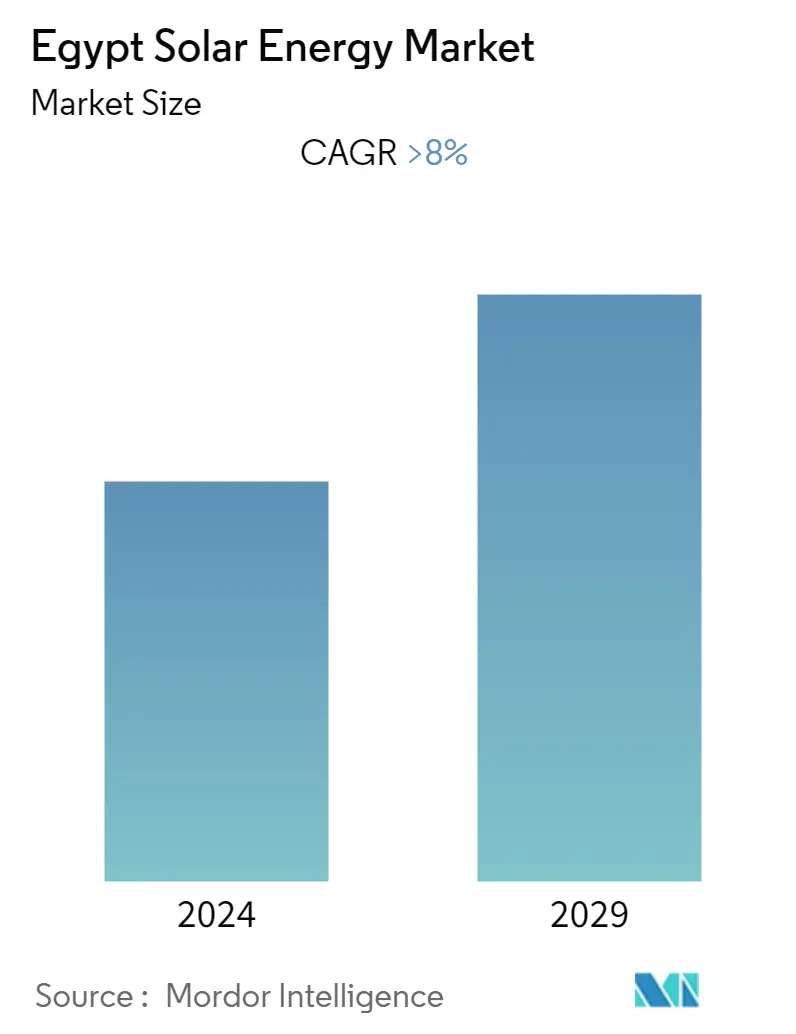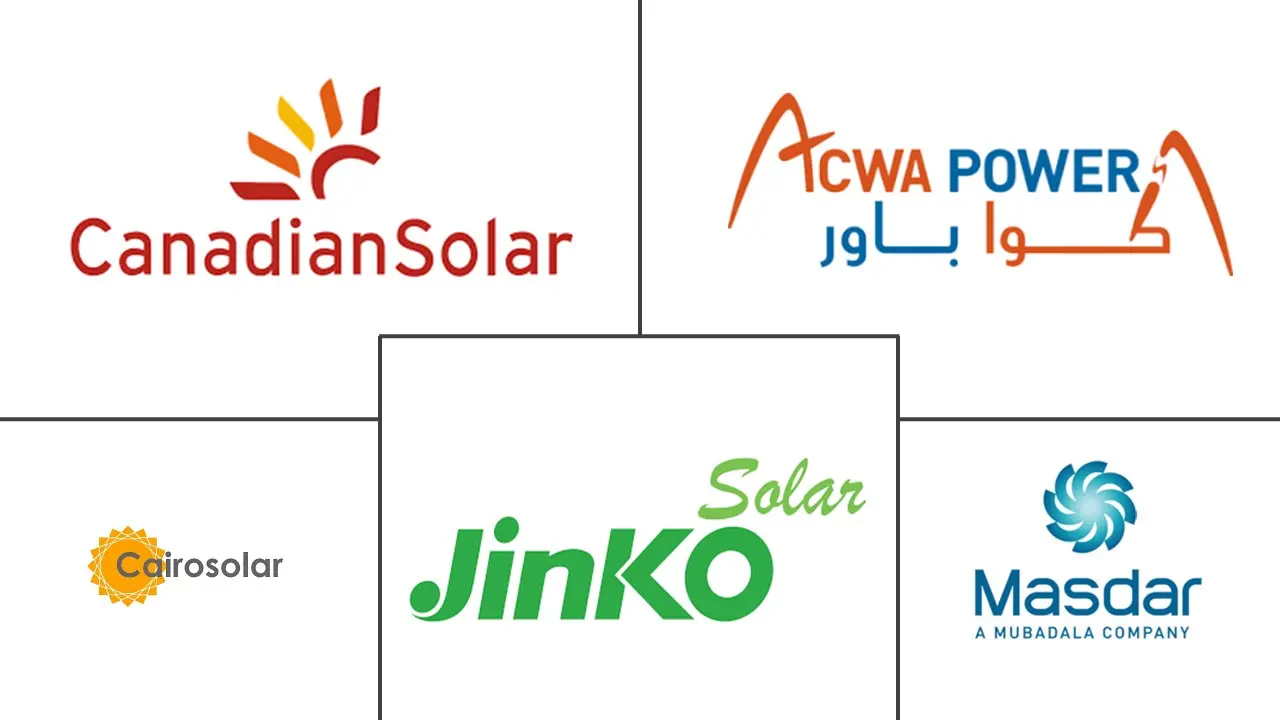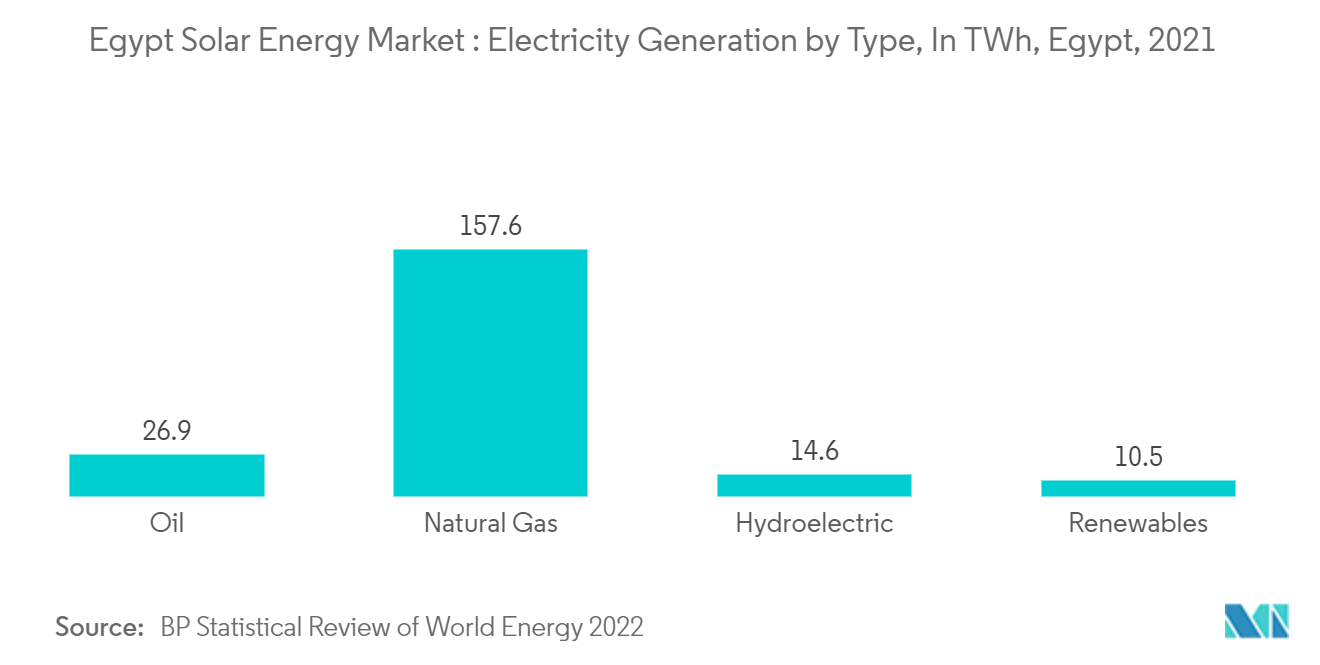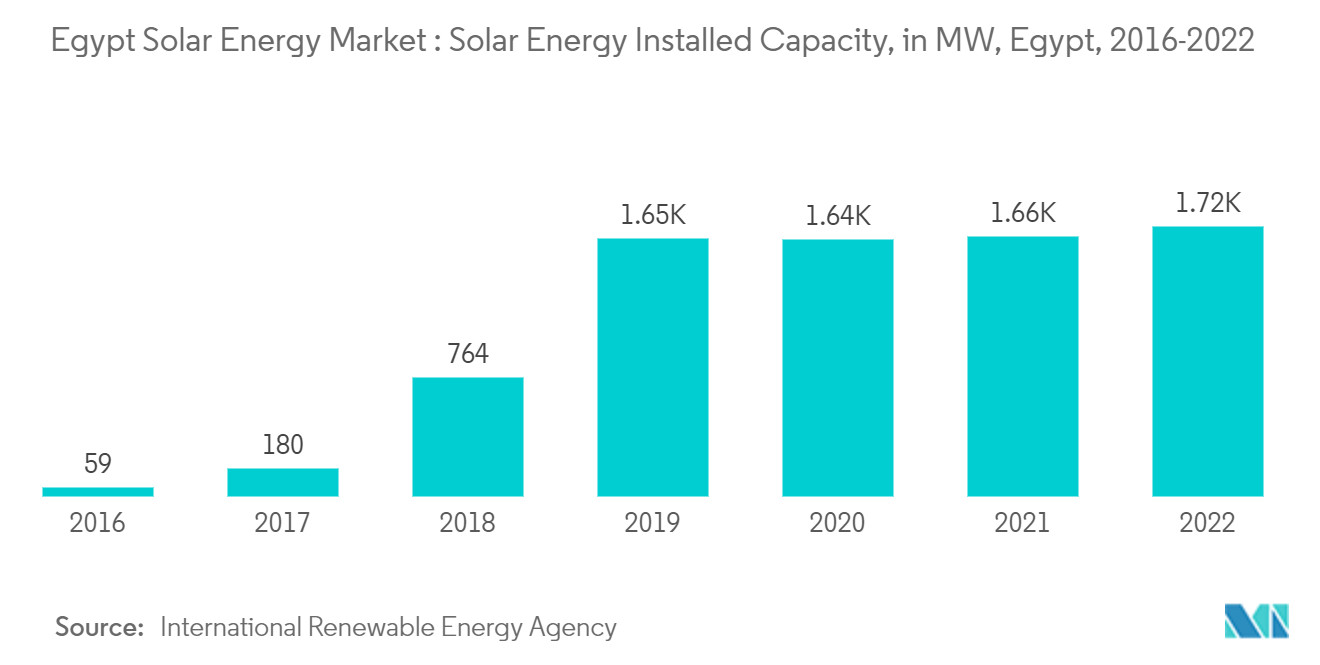Egypt Solar Energy Market Size

| Study Period | 2019 - 2029 |
| Base Year For Estimation | 2023 |
| Forecast Data Period | 2024 - 2029 |
| Historical Data Period | 2019 - 2022 |
| CAGR | > 8.00 % |
| Market Concentration | Medium |
Major Players
*Disclaimer: Major Players sorted in no particular order |
Egypt Solar Energy Market Analysis
The Egyptian solar market is expected to register a CAGR of more than 8% during the forecast period.
The market was negatively impacted by the outbreak of COVID-19 due to delays in ongoing and upcoming projects. Currently, the market has reached pre-pandemic levels.
- Factors such as supportive government policies and incentives for the solar sector and rapidly declining prices of solar modules are expected to drive the market.
- However, insufficient domestic manufacturing capacity of solar panels and related hardware and dependence on imports, which are subject to supply chain disruptions, are expected to restrain the growth of the market during the forecast period.
- The geography of Egypt consists of large tracts of uninhabited desert land in the Suez Peninsula and the western desert, with solar photovoltaic potential in excess of 2000 kWh/KWp/year. The maximum utilization of the natural geography and the high domestic solar potential of Egypt are expected to provide significant growth opportunities for the Egyptian solar market beyond the forecast period.
Egypt Solar Energy Market Trends
On-Grid Technology to Dominate the Market
- Egypt has connected a large capacity of solar energy to the grid over the past few years. Most of this capacity comes from large-scale ground-mounted projects, such as the 1.4 GW Benban Solar Park. However, many grid-connected small-scale solar system projects have also been connected to the grid during the same time, increasing the on-grid solar capacity.
- In Egypt, the New and Renewable Energy Authority (NREA) collaborates with the National Project Grid-Connected Small-Scale Photovoltaic Systems (Egypt-PV) to promote the design and implementation of small-scale solar systems with capacities less than 500 kilowatts, create replicable models, in addition to providing technical and financial support for these projects, and support the development of the solar PV market in Egypt. The Global Environment Facility (GEF) is funding the Industrial Modernization Center's (IMC) implementation of the Egypt PV project in collaboration with the United Nations Development Program (UNDP).
- Egypt PV has already provided technical and financial assistance for about 150 pilot PV projects in various sectors, such as industrial, educational, commercial, public, tourism, and residential. Of these, 123 solar PV projects with capacities between 5 and 500 kW were completed across Egypt, with many other projects currently underway. According to NREA, these projects have led to annual power savings of nearly 14.8 GWh.
- The government has developed a 2035 Integrated Sustainable Energy Strategy, which emphasizes the importance of renewable energy in the country. Egypt's government aims to increase the electricity supply generated from renewable sources to 42% by 2035. With a significant focus on photovoltaic energy providing 21.3%, wind providing 14%, hydropower at 1.98%, concentrating solar power at 5.52%, and conventional energy sources at 57.33% by 2035. In 2012, the solar energy production capacity was 15 MW, and in 2021 it reached 1,655 MW.
- Under this project, many PV systems were implemented in various capacities. PV systems have been installed across six different hotels to meet their consumption needs in several governorates across Egypt, including Cairo, South Sinai, and the Red Sea. PV systems have also been deployed in the educational sector, and pilot models were implemented in two international and two national schools located in New Cairo on October 6 in the cities of Giza and Cairo.
- Owing to the above point, on-grid is expected to drive the market during the forecast period.

Supportive Government Policies and Initiatives Driving the Market Demand
- The Egyptian government's support in the form of advantageous incentives and policies has been one of the main factors contributing to the rapid growth of the Egyptian solar market. The government formulated plans under its National Renewable Energy Strategy to increase the share of renewable energy in the national energy mix to 20% by 2022 and further double it to 42% by 2035. To achieve these goals, the government has also been regularly updating its solar energy policy to maximize the growth of the sector according to market conditions. Egyptian government agencies have also been actively involved in the adoption and commercialization of smaller solar PV systems for residential, commercial, and industrial customers.
- In March 2022, the Egyptian Electricity Utility & Consumer Protection Regulatory Agency (Egyptera) approved new incentives for net metering and self-consumption solar power systems to support utility-scale solar project developers. These incentives were approved as a part of an effort to encourage investments in the renewable energy sector ahead of COP27 in November 2022.
- According to the new incentives, Egyptera has decided to entirely remove the cap on the amount of solar energy private-sector players can generate under net metering, which had restricted installed solar capacity per distribution company to 1.5% of the company's maximum distribution capacity during the previous fiscal year.
- The new amendments have also raised the limit on the aggregate capacity of all developers across the country under the net metering scheme from 300 MW previously to 1 GW. Additionally, the ministry has also decided to raise the cutoff capacity for projects obliged to pay integration fees from 500 kW to 1 MW. Project developers developing projects with capacities in excess of 1 MW have to pay an integration fee of EGP 0.257-0.329 per KWh to help defray the costs of connecting to the national grid.
- For small-scale consumers, Egypt's New and Renewable Energy Authority (NREA) has created the National Project Grid-Connected Small-Scale Photovoltaic Systems (Egypt-PV) to promote the design and implementation of small-scale solar systems with capacities less than 500 kW. The program consists of the creation of replicable models, providing technical and financial support for such projects, and supporting the development of the solar PV market in Egypt.
- The Global Environment Facility (GEF) is funding the Industrial Modernization Center's (IMC) implementation of the Egypt PV project in collaboration with the United Nations Development Program (UNDP). Overall, the project has provided technical and financial support for a total capacity of about 10 MW, with total investments amounting to EGP 140 million, of which EGP 19 million are non-refundable grants.
- Egypt PV has already provided technical and financial assistance for about 150 pilot PV projects in various sectors, such as industrial, educational, commercial, public, tourism, and residential. In 2020, 123 solar PV projects with capacities between 5 and 500 kW were completed across Egypt, with many other projects in progress. According to NREA, these projects have led to annual power savings of nearly 14.8 GWh.
- A constant updating of market policies according to the market environment and supportive government policies and incentives for both small-scale and utility-scale solar project owners, such as the Egypt-PV program, are expected to provide a considerable impetus to the Egypt Solar Market during the forecast period.

Egypt Solar Energy Industry Overview
The Egyptian solar energy market is moderately concentrated. Some of the key players in the market (in no particular order) are Canadian Solar Inc., JinkoSolar Holding Co. Ltd., ACWA Power Co., Masdar (Abu Dhabi Future Energy Company), and Cairo Solar.
Egypt Solar Energy Market Leaders
-
Cairo Solar
-
ACWA Power Co
-
Masdar (Abu Dhabi Future Energy Company)
-
Canadian Solar Inc.
-
JinkoSolar Holding Co., Ltd.
*Disclaimer: Major Players sorted in no particular order

Egypt Solar Energy Market News
- February 2022: Irish renewable energy company Amarenco signed a deal with Egyptian energy company SolarizEgypt under which both companies are supposed to enter a partnership to jointly develop a 300 MW solar power portfolio for commercial and industrial (C&I) customers in Egypt. Amarenco is expected to acquire 74% of SolarizEgypt's existing 50 MW solar portfolio, and the partnership is expected to invest approximately USD 255 million over the next four years.
- February 2022: Makadi Heights, a fully integrated township project in the Red Sea area owned by Orascom Development, signed a contract with SolarizEgypt to develop a 1.5 MW dedicated solar power plant for the project. Makadi Heights develops the project through a Build, Operate, and Transfer (BOT) model under a 25-year corporate power purchase agreement (PPA) with SolarizEgypt. The total investment in the project is estimated to be nearly USD 11.5 million, and the project is expected to commence its commercial operation in Q1 2023.
Egypt Solar Energy Market Report - Table of Contents
1. INTRODUCTION
1.1 Scope of the Study
1.2 Market Definition
1.3 Study Assumptions
2. EXECUTIVE SUMMARY
3. RESEARCH METHODOLOGY
4. MARKET OVERVIEW
4.1 Introduction
4.2 Electricity Generation Mix, 2022
4.3 Renewable Energy Mix, 2022
4.4 Solar Energy Installed Capacity and Forecast, in MW, till 2028
4.5 Recent Trends and Developments
4.6 Government Policies and Regulations
4.7 Key Projects Information
4.8 Market Dynamics
4.8.1 Drivers
4.8.2 Restraints
4.9 Supply Chain Analysis
4.10 PESTLE Analysis
5. MARKET SEGEMENTATION
5.1 Technology
5.1.1 Solar Photovoltaic (PV)
5.1.2 Concentrated Solar Power (CSP)
5.2 Deployment
5.2.1 On-grid
5.2.2 Off-grid
6. COMPETITIVE LANDSCAPE
6.1 Mergers and Acquisitions, Collaborations, Joint Ventures, and Agreements
6.2 Strategies Adopted by Leading Players
6.3 Company Profiles
6.3.1 Egyptian Electricity Holding Company
6.3.2 KarmSolar
6.3.3 Infinity Solar
6.3.4 Cairo Solar
6.3.5 SolarizEgypt
6.3.6 ACWA Power Co.
6.3.7 Canadian Solar Inc.
6.3.8 JinkoSolar Holding Co. Ltd.
6.3.9 Abengoa SA
6.3.10 Masdar (Abu Dhabi Future Energy Company)
6.3.11 EDF Group
- *List Not Exhaustive
7. MARKET OPPORTUNITIES AND FUTURE TRENDS
Egypt Solar Energy Industry Segmentation
Solar energy is the conversion of energy present in the sun and is one of the renewable energies. Once the sunlight passes through the earth's atmosphere, most of it is in the form of visible light and infrared radiation. Solar cell panels are used to convert this energy into electricity.
The Egyptian solar energy market is segmented by technology and deployment. By technology, the market is segmented into solar photovoltaic (PV) and concentrated solar photovoltaic (CSP). By deployment, the market is segmented into on-grid and off-grid. For each segment, market sizing and forecasts have been done based on installed capacity (megawatts).
Egypt Solar Energy Market Research FAQs
What is the current Egypt Solar Energy Market size?
The Egypt Solar Energy Market is projected to register a CAGR of greater than 8% during the forecast period (2024-2029)
Who are the key players in Egypt Solar Energy Market?
Cairo Solar, ACWA Power Co, Masdar (Abu Dhabi Future Energy Company), Canadian Solar Inc. and JinkoSolar Holding Co., Ltd. are the major companies operating in the Egypt Solar Energy Market.
What years does this Egypt Solar Energy Market cover?
The report covers the Egypt Solar Energy Market historical market size for years: 2019, 2020, 2021, 2022 and 2023. The report also forecasts the Egypt Solar Energy Market size for years: 2024, 2025, 2026, 2027, 2028 and 2029.
Solar Power Egypt Industry Report
Statistics for the 2024 Solar Power Egypt market share, size and revenue growth rate, created by ����vlog��ý™ Industry Reports. Solar Power Egypt analysis includes a market forecast outlook to 2029 and historical overview. Get a sample of this industry analysis as a free report PDF download.



